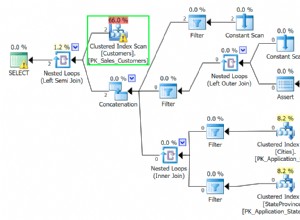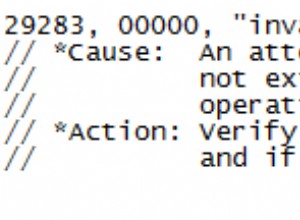Użycie kursora wymaga otoczonego standardowym standardowym kodem.
Użycie kursora do wywołania procedury składowanej dla każdego zestawu wartości z tabeli wymaga zasadniczo tego samego schematu. SELECT wartości, które chcesz przekazać, skądkolwiek je otrzymujesz (może to być tabela tymczasowa, tabela podstawowa lub widok i może zawierać wywołania funkcji składowanych), a następnie wywołaj procedurę z tymi wartościami.
Poniżej napisałem poprawny składniowo przykład tego standardowego kodu z komentarzami wyjaśniającymi, co robi każdy komponent. Jest kilka rzeczy, których nie lubię bardziej niż proszenie o zrobienie czegoś „tylko dlatego”, więc wszystko jest (miejmy nadzieję) wyjaśnione.
Wspomniałeś o wywołaniu procedury z wieloma wartościami, więc w tym przykładzie użyto 2.
Zwróć uwagę, że zdarzenia, które się jej zdarzają, są z jakiegoś powodu w określonej kolejności. Zmienne muszą być zadeklarowane jako pierwsze, kursory muszą być zadeklarowane przed ich obsługą kontynuacji, a pętle muszą podążać za wszystkimi tymi rzeczami. Sprawia to wrażenie, że jest tu dość ekstremalna nieelastyczność, ale tak nie jest. Możesz zresetować kolejność, zagnieżdżając dodatkowy kod w BEGIN ... END bloki w obrębie ciała zabiegowego; na przykład, jeśli potrzebujesz drugiego kursora wewnątrz pętli, po prostu zadeklaruj go wewnątrz pętli, wewnątrz innego BEGIN ... END .
DELIMITER $$
DROP PROCEDURE IF EXISTS `my_proc` $$
CREATE PROCEDURE `my_proc`(arg1 INT) -- 1 input argument; you might not need one
BEGIN
-- from http://stackoverflow.com/questions/35858541/call-a-stored-procedure-from-the-declare-statement-when-using-cursors-in-mysql
-- declare the program variables where we'll hold the values we're sending into the procedure;
-- declare as many of them as there are input arguments to the second procedure,
-- with appropriate data types.
DECLARE val1 INT DEFAULT NULL;
DECLARE val2 INT DEFAULT NULL;
-- we need a boolean variable to tell us when the cursor is out of data
DECLARE done TINYINT DEFAULT FALSE;
-- declare a cursor to select the desired columns from the desired source table1
-- the input argument (which you might or might not need) is used in this example for row selection
DECLARE cursor1 -- cursor1 is an arbitrary label, an identifier for the cursor
CURSOR FOR
SELECT t1.c1,
t1.c2
FROM table1 t1
WHERE c3 = arg1;
-- this fancy spacing is of course not required; all of this could go on the same line.
-- a cursor that runs out of data throws an exception; we need to catch this.
-- when the NOT FOUND condition fires, "done" -- which defaults to FALSE -- will be set to true,
-- and since this is a CONTINUE handler, execution continues with the next statement.
DECLARE CONTINUE HANDLER FOR NOT FOUND SET done = TRUE;
-- open the cursor
OPEN cursor1;
my_loop: -- loops have to have an arbitrary label; it's used to leave the loop
LOOP
-- read the values from the next row that is available in the cursor
FETCH NEXT FROM cursor1 INTO val1, val2;
IF done THEN -- this will be true when we are out of rows to read, so we go to the statement after END LOOP.
LEAVE my_loop;
ELSE -- val1 and val2 will be the next values from c1 and c2 in table t1,
-- so now we call the procedure with them for this "row"
CALL the_other_procedure(val1,val2);
-- maybe do more stuff here
END IF;
END LOOP;
-- execution continues here when LEAVE my_loop is encountered;
-- you might have more things you want to do here
END $$
DELIMITER ;




